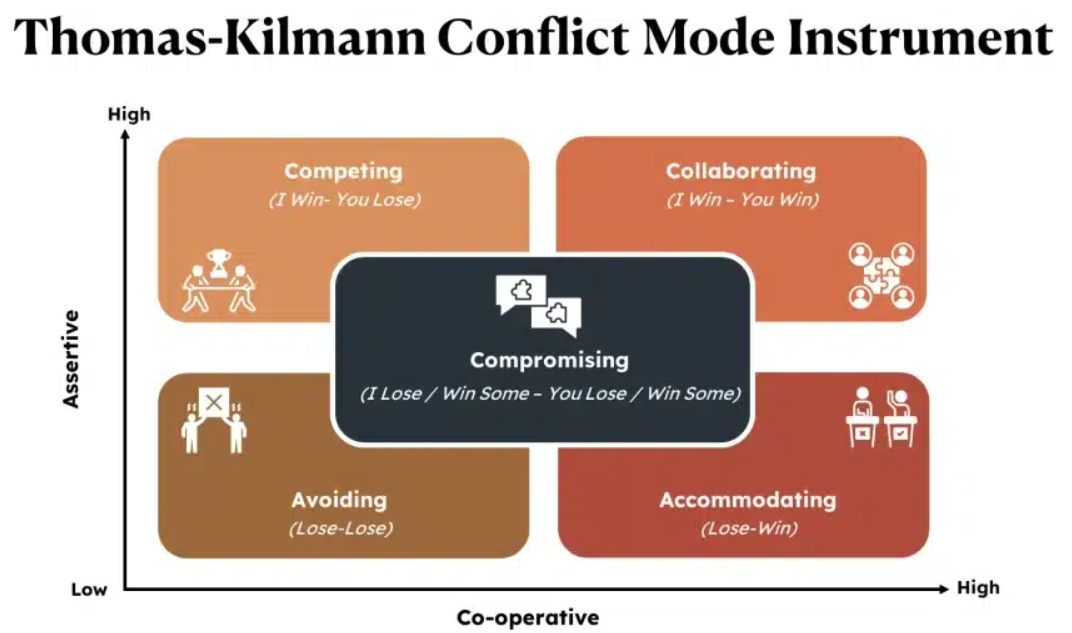Any situation where you live, work, and collaborate with others is susceptible to conflict. As a musician or composer, you will have professional relationships with many different personalities, with diverse opinions and daily lives and discord is bound to occur. To navigate it, it’s crucial to understand why it arises and your options for resolving it.
Common reasons for conflict include:
- Misunderstandings or poor communication skills
- Differing opinions, viewpoints, or personalities
- Variations in learning or processing styles
- Perceptions of unfairness
- Lack of clear frameworks to manage differences of opinion
What to do in the moment of conflict
When a conflict arises, take a step back to thoroughly understand the issues at hand. Listen actively to the other party’s concerns without interrupting. This shows respect and can often reveal the root cause of the disagreement. Once you have a clear picture, articulate your own perspective in a calm and rational manner. Remember, the goal is not to win an argument but to find a mutually acceptable solution that maintains the business relationship.
Clear communication is the cornerstone of conflict resolution. Articulate your thoughts and feelings without assigning blame or getting defensive. Use “I” statements to express how the situation affects you personally, which can prevent the other party from feeling attacked. Ensure that you understand each other’s points by summarising what you’ve heard and asking for clarification if needed.
Setting clear boundaries is crucial in preventing and managing conflicts. Define the scope of work, deadlines, and payment terms upfront to avoid misunderstandings later on. If a conflict does arise, refer back to these agreed-upon terms. Be firm yet respectful in enforcing your boundaries, as this will help maintain professional integrity and prevent similar issues in the future.
Focus on finding solutions rather than dwelling on the problem. Brainstorm possible outcomes that would satisfy both parties and be open to compromise. The key is to approach the situation with a problem-solving mindset and a willingness to adapt.
Throughout any conflict, it is important to maintain professionalism. This means controlling your emotions, being respectful, and keeping the conversation focused on business objectives. Avoid personal attacks or emotional outbursts, as they can damage your reputation and the relationship. By staying professional, you demonstrate your commitment to resolving the issue and maintaining a positive working environment.
With so much collaboration in creative work, there will be times when you experience conflict with those you’re working with.
It can be helpful to work out whether the conflict you’re experiencing is about the task itself (‘creative differences’) or is more relationship based. Studies have shown that task conflict can be beneficial for performance, whereas relationship conflict can have a negative impact on co-worker trust. If you experience task conflict, try to keep things constructive and focused on the work itself without escalating into a personal conflict too.
In challenging conflict situations, it is very helpful to be able to balance your emotions and express them appropriately. Emotion Regulation (ER) has been defined as “the ways individuals influence which emotions they have, when they have them, and how they experience and express these emotions” (Gross, 1999b, p. 557).
This helps to maintain balance, ensuring that emotions do not overwhelm or disrupt our day-to-day functioning (McRae & Gross, 2020).
Healthy emotion regulation is built on a foundation of three key factors (Naragon-Gainey et al., 2017):
- Being able to disengage from the intensity of the emotion
- Being able to interrupt the cycle of rumination
- Being able to reengage with the situation adaptively
The following examples of healthy emotion regulation can be helpful:
- Reframing negative thoughts
When faced with a challenging situation, rather than catastrophizing, reframe the event to focus on the learning opportunity or silver lining - Acceptance and mindfulness
In moments of intense stress, practice acceptance and mindfulness to calm the nervous system and regain emotional equilibrium - Take a break
Recognize when an emotion such as anger is escalating. Temporarily remove yourself from the situation to cool down before responding - Express emotions constructively
Use calm, assertive communication to express feelings appropriately instead of bottling them up or lashing out - Problem-solving
Instead of ruminating on negative feelings, identify actionable steps to address the root cause of the emotion
Ugne’s research into Emotional Regulation Techniques in Self-Regulated Learning for musicians suggests that including emotion regulation in educational institutions and workplaces can support musical achievement.
Although conflict is common, many don’t feel comfortable handling it—especially with colleagues. While there are several approaches to conflict, some can be more effective than others.
The Thomas-Kilmann Conflict Model—developed by Dr. Kenneth W. Thomas and Dr. Ralph H. Kilmann—outlines five strategies for conflict resolution:
- Avoiding
- Competing
- Accommodating
- Compromising
- Collaborating
These fall on a graph, with assertiveness on the y-axis and cooperativeness on the x-axis. In the Thomas-Kilmann model, “assertiveness” refers to the extent to which you try to reach your own goal, and “cooperativeness” is the extent to which you try to satisfy the other party’s goal.
Alternatively, you can think of these axis labels as the “importance of my goal” and the “importance of this relationship.” If your assertiveness is high, you aim to achieve your own goal. If your cooperativeness is high, you strive to help the other person reach theirs to maintain the relationship.
Here’s a breakdown of the five strategies and when to use each.
1. Avoiding
Avoiding is a strategy best suited for situations in which the relationship’s importance and goal are both low.
If your goal conflicts with someone you are unlikely to have a long-term relationship with, then avoidance is a reasonable strategy, but where you care about maintaining a lasting relationship with colleagues—avoidance can be detrimental.
2. Competing
Competing is another strategy that can be useful in some situations. This might be used when you place high importance on your goal and low importance on your relationships with others.
It’s high in assertiveness and low in cooperation. You might use it when standing up for yourself and in instances where you feel unsafe. In those cases, asserting yourself and reaching safety is more critical than your relationships with others.
When using a competing style in situations where your relationships do matter you risk impeding trust—along with collaboration, creativity, and productivity.
3. Accommodating
The third conflict resolution strategy is accommodation, in which you acquiesce to the other party’s needs.
Use accommodating in instances where the relationship matters more than your goal.
This is useful if the other person is angry or hostile or you don’t have a strong opinion on the matter. It immediately deescalates conflict by removing your goal from the equation.
On the other hand, just giving in may stop creative solutions from being developed and could be a sign that people don’t feel safe enough to have a healthy debate.
4. Compromising
Compromising is a conflict resolution strategy in which you and the other party willingly forfeit some of your needs to reach an agreement. It’s known as a “lose-lose” strategy, since neither of you achieve your full goal.
This strategy works well when your care for your goal and the relationship are both moderate. You value the relationship, but not so much that you abandon your goal, like in accommodation.
Compromising requires big-picture thinking and swallowing your pride, knowing you won’t get all your needs fulfilled. The benefits are that you and the other party value your relationship and make sacrifices to reach a mutually beneficial resolution
5. Collaborating
Where compromise is a lose-lose strategy, collaboration is a win-win.
In instances of collaboration, your goal and the relationship are equally important, motivating both you and the other party to work together to find an outcome that meets all needs. Collaboration is ideal for most workplace conflicts. Goals are important but so is maintaining positive relationships with the people you work with.
After a conflict has been resolved, it’s important to follow up to ensure that both parties are satisfied with the outcome and that the agreed-upon solutions are being implemented. This reinforces the resolution and helps prevent future misunderstandings. It also shows that you value the relationship and are invested in its success.
A simple check-in can go a long way in maintaining trust and respect.
Bullying and Harassment
In some situations, it may be that conflict has escalated to bullying or harassment. This is not acceptable, and there is help and support available.
The Creative Industries Independent Standards Authority (CIISA) has been established to uphold and improve standards of behaviour across creative industries and to prevent and tackle all forms of bullying and harassment. It will support the film, TV, theatre and music industries and provide a single place of accountability where behaviours of concern can be reported and investigated.
Further support is available from the Musicians’ Union. Discrimination & Harassment Advice For Musicians | Musicians’ Union | MU | The MU
Help Musicians also offer a bullying and harassment helpline confidentially for free on 0800 088 2045.
Gross, J. J. (1999b). Emotion regulation: past, present, future. Cogn. Emot. 13, 551–573. doi: 10.1080/026999399379186
Emotional Regulation: 5 Evidence-Based Regulation Techniques



